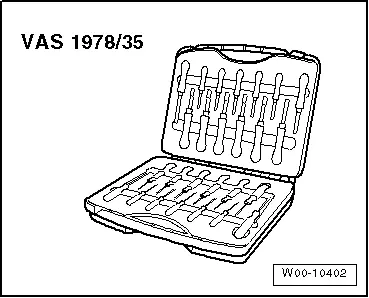Audi Q5: Passenger Occupant Detection System
Component Location Overview - Passenger Occupant Detection System
 WARNING
WARNING
The replacement part (service kit) for the passenger occupant detection system is already precalibrated and must not be separated under any circumstances. The service kit consists of:
- Passive Occupant Detection System Control Module -J706
- Passive Occupant Detection System Pressure Sensor -G452
- Passive Occupant Detection System Mat
- Seat cushion
- Wiring harness between the passenger occupant detection system control module -J706 and passenger occupant detection system pressure sensor -G452.
 WARNING
WARNING
Follow all safety precautions when working on the passenger occupant detection system. Refer to → Chapter "Passenger Occupant Detection System Deactivation Additional Safety Precautions, Market-Specific".
 Note
Note
The passenger occupant detection system is only installed in the front passenger seat.
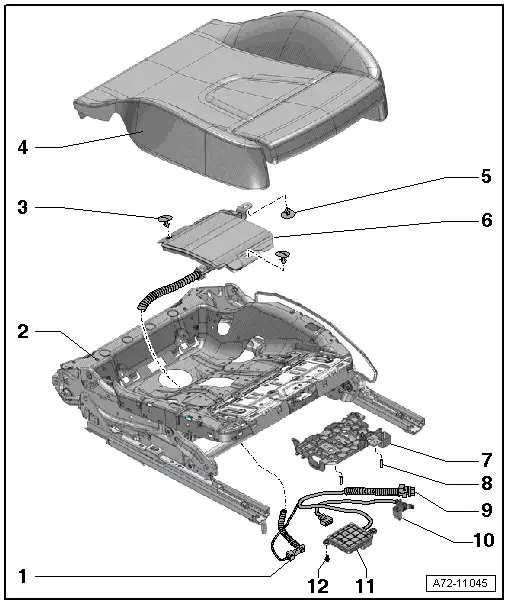
1 - Passenger Occupant Detection System Pressure Sensor -G452-
- Is part of the seat occupied recognition mat -6-
- Removing and installing. Refer to → Chapter "Passenger Occupant Detection System, Removing and Installing".
 Caution
Caution
Do not disconnect the electrical connector.
2 - Lower Seat Frame
3 - Clip
4 - Cushion
- For the lower seat frame
- Do not separate from the seat occupied recognition mat -6-
5 - Clip
- Do not release.
6 - Mat
- For the passenger occupant detection system
- Is a component of the Passenger Occupant Detection System Pressure Sensor -G452-
- Do not separate from the seat pan upholstery -4-
- Removing and installing. Refer to → Chapter "Passenger Occupant Detection System, Removing and Installing".
7 - Mount
- Equipment levels
- For the Passenger Occupant Detection System Control Module -J706-
8 - Expanding Pin
- For securing the mount to the lower seat frame
9 - Wiring Harness
- Do not separate from the Passenger Occupant Detection System Pressure Sensor -G452- and Passenger Occupant Detection System Control Module -J706-
10 - Front Passenger Seat Position Sensor -G554-
- Is a component of the electrical wiring harness -9-
- Removing and installing. Refer to → Chapter "Seat Position Sensor, Removing and Installing, with Seat Occupied Sensor for Passenger Airbag Deactivation".
11 - Passenger Occupant Detection System Control Module -J706-
- Removing and installing. Refer to → Chapter "Passenger Occupant Detection System, Removing and Installing".
 Caution
Caution
Do not disconnect the electrical connector.
12 - Bolt
- 1.5 Nm
Passenger Occupant Detection System, Removing and Installing
Special tools and workshop equipment required
- Pry Lever -80 - 200-
 WARNING
WARNING
- Follow all safety precautions when working with pyrotechnic components (refer to → Chapter "Pyrotechnic Components Safety Precautions") and on the passenger occupant detection system (refer to → Chapter "Passenger Occupant Detection System Deactivation Additional Safety Precautions, Market-Specific").
- Before handling pyrotechnic components (for example, disconnecting the connector), the person handling it must "discharge static electricity". This can be done by touching the door striker, for example.
 WARNING
WARNING
The replacement part (service kit) for the passenger occupant detection system is already precalibrated and must not be separated under any circumstances. The service kit consists of:
- Passenger Occupant Detection System Control Module -J706-
- Passenger Occupant Detection System Pressure Sensor -G452-
- Passive Occupant Detection System Mat
- Seat cushion
- Wiring harness between the Passenger Occupant Detection System Control Module -J706- and Passenger Occupant Detection System Pressure Sensor -G452-
Removing
- Move the seat height to the middle position before removing the seat.
- Remove the front passenger seat. Refer to → Chapter "Front Seat, Removing and Installing".
- Disconnect the battery ground cable with the ignition turned on. Refer to → Electrical Equipment; Rep. Gr.27; Battery; Battery, Disconnecting and Connecting.
- Attach the front seat to the Engine/Transmission Holder - Seat Repair Fixture -VAS6136-. Refer to → Chapter "Front Seat, Mounting on Fixture for Seat Repair".
- Remove the front seat backrest. Refer to → Chapter "Front Backrest, Removing And Installing, Standard Seat/Comfort Seat/Sport Seat".
 Caution
Caution
Do not disconnect the electrical connectors on the Passenger Occupant Detection System Pressure Sensor -G452- and the Seat Occupied Recognition Control Module -J706-.
- Using a narrow screwdriver, carefully press the Passenger Occupant Detection System Pressure Sensor -G452--item 3- off the bracket -arrow-.
- Open the seat occupied recognition pressure hose guide -1- and free up the pressure hose -2-.
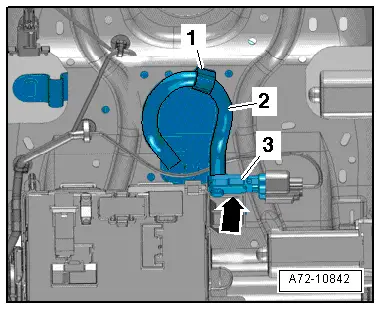
- Remove the screw -2- and remove the Passenger Occupant Detection System Control Module -J706--item 1- from the retainer.
- Disconnect the safety belt latch connector from the bracket by pressing the release and removing the electrical connector.
- Free up electrical wiring harness.
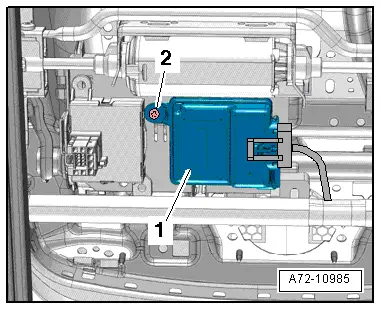
- Remove the bolt -1-.
- Unclip and remove the Front Passenger Seat Position Sensor -G554--item 2-.
- Remove cover and cushion (seat pan without a seat depth adjuster) from the seat pan and carefully fold it to the side. Refer to → Chapter "Seat Pan Cover and Upholstery, Removing and Installing, Standard, Comfort Seat".

- Carefully pry out the seat occupied recognition mat clips -1- and -3- on the front of the seat pan using a Pry Lever -80 - 200-.
- Remove the seat pan cover with upholstery by first guiding the Passenger Occupant Detection System Pressure Sensor -G452- with the wiring harness through the opening in the seat pan. Guide the Passenger Occupant Detection System Control Module -J706- through the opening last.
 WARNING
WARNING
Damage risk.
Do not bend the seat occupied recognition pressure hose and mat.
- Remove the seat pan cover with upholstery with the seat occupied recognition mat -2-, the Passenger Occupant Detection System Pressure Sensor -G452- and the Passenger Occupant Detection System Control Module -J706-.
- Separate the cover from the seat pan upholstery. Refer to → Chapter "Lower Seat Frame Cover and Cushion, Separating, Standard, Comfort, Folding Seat".
 Caution
Caution
Do not separate the seat pan cushion from the seat occupied recognition mat.
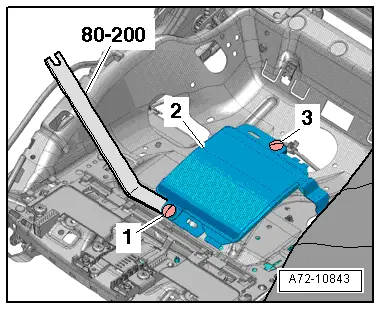
Installing
 Caution
Caution
Do not disconnect the electrical connectors on the Passenger Occupant Detection System Pressure Sensor -G452- and the Seat Occupied Recognition Control Module -J706-.
Install in reverse order of removal. Note the following:
 WARNING
WARNING
- Follow all safety precautions when working with pyrotechnic components (refer to → Chapter "Pyrotechnic Components Safety Precautions") and on the passenger occupant detection system (refer to → Chapter "Passenger Occupant Detection System Deactivation Additional Safety Precautions, Market-Specific").
- Before handling pyrotechnic components (for example, connecting the connector), the person handling it must "discharge static electricity". This can be done by touching the door striker, for example.
- Do not bend the seat occupied recognition pressure hose and mat.
 Note
Note
Make sure the connectors are installed correctly and are secure.
 WARNING
WARNING
Ignition must be on when connecting battery. If pyrotechnic components (for example, airbag, belt tensioner) are not repaired correctly, they may deploy unintentionally after connecting battery. There must not be anyone inside the vehicle when connecting the battery.
 DANGER!
DANGER!
When working on vehicles with the ignition already switched on or that are ready to drive there is a danger of the engine starting unexpectedly and of being poisoned by gas in enclosed areas. Risk of body parts and/or clothing being clamped or pulled.
Perform the following before switching on the ignition:
- Move the selector lever into P.
- Activate the parking brake
- Turn off the ignition.
- Open the hood
- Connect Battery Charger -VAS5095A- to the battery jump start terminal.
- Turn on the ignition.
- Connect the battery ground cable with the ignition turned on. Refer to → Electrical Equipment; Rep. Gr.27; Battery; Battery, Disconnecting and Connecting.
When installing a new service kit and after each repair to the front passenger seat during which the seat and/or the backrest cover is "disengaged", a basic setting procedure must be performed for the passenger occupant detection system control module. Refer to → Chapter "Passenger Occupant Detection System Deactivation Additional Safety Precautions, Market-Specific".
- At the end, select the "Airbag" function in "guided fault finding" using Vehicle Diagnostic Tester.
- Seat Occupied Recognition Control Module -J706- basic setting
Special Tools
- Trim Removal Wedge -3409-

- Pry Lever -80 - 200-

- Release Tool Set - Extraction Tool 17 -VAS1978/17- from the Release Tool Set -VAS1978/35-.
